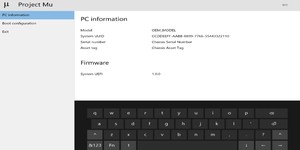Yesterday, John Du, General Manager of Intel China, offered a tantalising titbit about the future of UEFI (that’s the Unified Extensible Firmware Interface to the rest of us): it is still on track and should cure most of our BIOS-related headaches.
The BIOS is currently 22 years old but very few people know how to code for it. Hiring those who know Assembly language was respectively easier back in 1985 than it is now, where more people are adept in higher language codes like C/C++.
UEFI is the future of computing firmware that Intel has been trying to push for some time. It has a more open interface and not only is better in software by using that higher level language code but the physical hardware to contain occupies about a 10th of the footprint a normal BIOS uses.
Current BIOS’ are pushed to their absolute limits and are very complicated to understand and diagnose. The instability of many modern motherboards is mostly due to BIOS problems, and quite a few people, including ourselves, regularly complain about the state of motherboards recently released on the market.
The spate of problems with early production runs can be traced back to the shortage of qualified and experienced BIOS engineers, people who are skilled enough to write and diagnose a BIOS, making it compatible with all hardware iterations as well as being super-overclockable and able to run ultra fast memory timings.
Very few motherboards have BIOS as comprehensive as the DFICFX3200 T2R/G, but that’s because legendary engineers like Oskar & Jarry employed at DFI, are extremely few and far between.
UEFI allows for far more creativity and modularity in the BIOS area as well, by expanding the use of a higher level language code meaning more people are available to code for it. This makes it easier to optimise, diagnose and layer, as well as providing far better performance allowing for a faster system boot up.
Intel described that it is basically very hard work to remove the depth of legacy integration currently in place, since there is such a deep engraining of support across the industry.
Today, after spotting the extremely helpful people at American Megatrends (AMI competitor to the ever popular Phoenix BIOS) had a booth with a working UEFI sample, it described that it was actually currently shipping it, but only in server applications where Microsoft is less overwhelmingly proficient.
Microsoft simply does not currently support UEFI, even in Vista, so hardware manufacturers are also reluctant to support it. Initially I was told it would be two to three years before general UEFI adoption. However, after a quick chat to someone in the know, the AMI rep (that spoke English) confirmed to me that Microsoft will be offering UEFI support as soon as Q4 this year through an OS update. AMI itself was completely ready to ship on mass, and are just waiting for the market to catch up.
Posing the questions as to whether it’s easier to overclock on a UEFI BIOS, AMI hinted that it shouldn’t be that much different for the end user from the fundamentals of current BIOS overclocking. It’ll just look prettier.
Intel is apparently still keeping its register information close to its chest, so it’s up to the work of motherboard vendors to discover what the chipset offers by the same current method of reverse engineering. It sucks, but it’s to be expected as some things never change.

 The hardware setup on AMI's display and the chip itself. It's an extremely tiny and simple 8-pin affair. This should make it very attractive for those who make small form factor motherboards like mini-ITX which have to make the most use of the available space.
The hardware setup on AMI's display and the chip itself. It's an extremely tiny and simple 8-pin affair. This should make it very attractive for those who make small form factor motherboards like mini-ITX which have to make the most use of the available space.

 The new interface looks like a normal GUI you'd find within any 32-bit program, which is far more than the simple 16 colours we're used to. UEFI is still limited to a VGA resolution to provide compatibility with every possible hardware variation, but it allows the use of a mouse as well as a keyboard, and even offers animation.
The new interface looks like a normal GUI you'd find within any 32-bit program, which is far more than the simple 16 colours we're used to. UEFI is still limited to a VGA resolution to provide compatibility with every possible hardware variation, but it allows the use of a mouse as well as a keyboard, and even offers animation.

 There are additional modes available than we are used to with current BIOS', like being able to switch individual PCI-Express lanes on and off on, as well as in built stress testing for any component.
There are additional modes available than we are used to with current BIOS', like being able to switch individual PCI-Express lanes on and off on, as well as in built stress testing for any component.
Discuss in the forums
The BIOS is currently 22 years old but very few people know how to code for it. Hiring those who know Assembly language was respectively easier back in 1985 than it is now, where more people are adept in higher language codes like C/C++.
UEFI is the future of computing firmware that Intel has been trying to push for some time. It has a more open interface and not only is better in software by using that higher level language code but the physical hardware to contain occupies about a 10th of the footprint a normal BIOS uses.
Current BIOS’ are pushed to their absolute limits and are very complicated to understand and diagnose. The instability of many modern motherboards is mostly due to BIOS problems, and quite a few people, including ourselves, regularly complain about the state of motherboards recently released on the market.
The spate of problems with early production runs can be traced back to the shortage of qualified and experienced BIOS engineers, people who are skilled enough to write and diagnose a BIOS, making it compatible with all hardware iterations as well as being super-overclockable and able to run ultra fast memory timings.
Very few motherboards have BIOS as comprehensive as the DFICFX3200 T2R/G, but that’s because legendary engineers like Oskar & Jarry employed at DFI, are extremely few and far between.
UEFI allows for far more creativity and modularity in the BIOS area as well, by expanding the use of a higher level language code meaning more people are available to code for it. This makes it easier to optimise, diagnose and layer, as well as providing far better performance allowing for a faster system boot up.
Intel described that it is basically very hard work to remove the depth of legacy integration currently in place, since there is such a deep engraining of support across the industry.
Today, after spotting the extremely helpful people at American Megatrends (AMI competitor to the ever popular Phoenix BIOS) had a booth with a working UEFI sample, it described that it was actually currently shipping it, but only in server applications where Microsoft is less overwhelmingly proficient.
Microsoft simply does not currently support UEFI, even in Vista, so hardware manufacturers are also reluctant to support it. Initially I was told it would be two to three years before general UEFI adoption. However, after a quick chat to someone in the know, the AMI rep (that spoke English) confirmed to me that Microsoft will be offering UEFI support as soon as Q4 this year through an OS update. AMI itself was completely ready to ship on mass, and are just waiting for the market to catch up.
Posing the questions as to whether it’s easier to overclock on a UEFI BIOS, AMI hinted that it shouldn’t be that much different for the end user from the fundamentals of current BIOS overclocking. It’ll just look prettier.
Intel is apparently still keeping its register information close to its chest, so it’s up to the work of motherboard vendors to discover what the chipset offers by the same current method of reverse engineering. It sucks, but it’s to be expected as some things never change.






Discuss in the forums

MSI MPG Velox 100R Chassis Review
October 14 2021 | 15:04









Want to comment? Please log in.